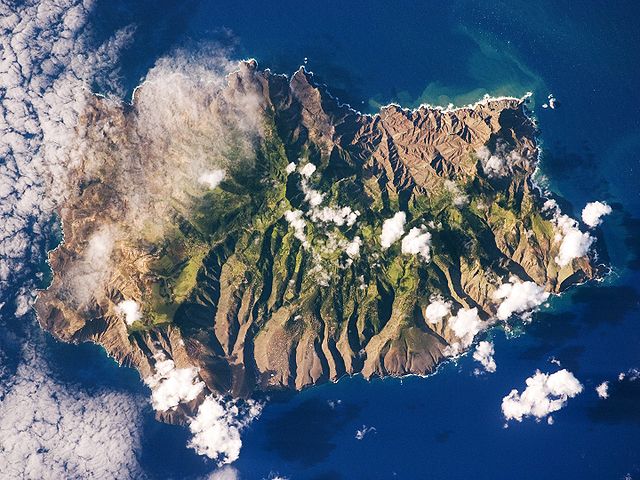
File:Saint Helena Island.jpg

| |
This is a file from the Wikimedia Commons. Information from its description page there is shown below.
Commons is a freely licensed media file repository. You can help. |
Summary
 |
This image has been assessed under the valued image criteria and is considered the most valued image on Commons within the scope: Saint Helena Island. You can see its nomination at Commons:Valued image candidates/Saint Helena Island.jpg.
|
| Description |
English: This astronaut photograph shows the island’s sharp peaks and deep ravines; the rugged topography results from erosion of the volcanic rocks that make up the island. The change in elevation from the coast to the interior creates a climate gradient. The higher, wetter centre is covered with green vegetation, whereas the lower coastal areas are drier and hotter, with little vegetation cover.
Français : Photo de l'île de Sainte Hélène prise par un astronaute de la NASA. On peut voir les pics élevés de l'île et ses ravines profondes. Cette topographie accidentée résulte de l'action de l'érosion sur les roches volcaniques dont l'île est constituée. Le changement d'élévation entre la périphérie et le centre de l'île créé un gradient climatique: le sommet est plus frais et humide, il est couvert de végétation. Les côtes, plus chaudes et sèches, laissent apparaitre la roche nue.
|
||||||||||||||||||||||||||||||||||||||||||||||||||||||
| Date | 7 May 2009 | ||||||||||||||||||||||||||||||||||||||||||||||||||||||
| Source | NASA Earth Observatory | ||||||||||||||||||||||||||||||||||||||||||||||||||||||
| Author | This image was taken by the NASA Expedition 19 crew. | ||||||||||||||||||||||||||||||||||||||||||||||||||||||
|
Camera location |
15° 56′ 59.90″ S, 5° 42′ 0.0″ W |
This and other images at their locations on: Google Maps - Google Earth - OpenStreetMap | ( Info)-15.949972222222;-5.7 |
|---|
This photograph was acquired with a Nikon 2DXs digital camera fitted with a 400 mm lens, and is provided by the ISS Crew Earth Observations experiment and Image Science & Analysis Laboratory, Johnson Space Centre.
Licensing
| Public domainPublic domainfalsefalse |
 |
This file is in the public domain because it was solely created by NASA. NASA copyright policy states that "NASA material is not protected by copyright unless noted". (See Template:PD-USGov, NASA copyright policy page or JPL Image Use Policy.) |
 |
 |
Warnings:
|
| Annotations | This image is annotated: View the annotations at Commons |
Jamestown
Sugarloaf Point
Speary Islands
Diana’s Peak
The Buoys
George Island
Barn Point
The Barn
Egg Island
South West Point
Manati Bay
Castle Rock Point
Sandy Bay
Sandy Bay Island
Powell Bay
Black Point
White Hill
Long Ground Ridge
Bay Point
Saddle Point
Stone Top Bay
Prosperous Bay
File usage
Metadata
| Camera manufacturer | NIKON CORPORATION |
|---|---|
| Camera model | NIKON D2Xs |
| Exposure time | 1/1,000 sec (0.001) |
| F-number | f/4 |
| ISO speed rating | 200 |
| Date and time of data generation | 08:37, 7 May 2009 |
| Lens focal length | 400 mm |
| Orientation | Normal |
| Horizontal resolution | 72 dpi |
| Vertical resolution | 72 dpi |
| Software used | Adobe Photoshop CS4 Macintosh |
| File change date and time | 13:28, 12 June 2009 |
| Exposure Program | Shutter priority |
| Exif version | 2.21 |
| Date and time of digitizing | 08:37, 7 May 2009 |
| Shutter speed | 9.965784 |
| APEX aperture | 4 |
| Exposure bias | 0 |
| Maximum land aperture | 3 APEX (f/2.83) |
| Metering mode | Pattern |
| Light source | Unknown |
| Flash | Flash did not fire |
| DateTime subseconds | 74 |
| DateTimeOriginal subseconds | 74 |
| DateTimeDigitized subseconds | 74 |
| Colour space | sRGB |
| Sensing method | One-chip colour area sensor |
| Custom image processing | Normal process |
| Exposure mode | Auto exposure |
| White balance | Auto white balance |
| Digital zoom ratio | 1 |
| Focal length in 35 mm film | 600 mm |
| Scene capture type | Standard |
| Contrast | Soft |
| Saturation | Normal |
| Sharpness | Normal |
| Subject distance range | Unknown |
Find out about Schools Wikipedia
Schools Wikipedia has made the best of Wikipedia available to students. The world's largest orphan charity, SOS Children's Villages brings a better life to more than 2 million people in 133 countries around the globe. Why not try to find out more about sponsoring a child?
